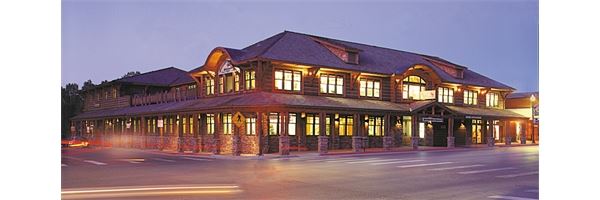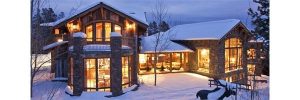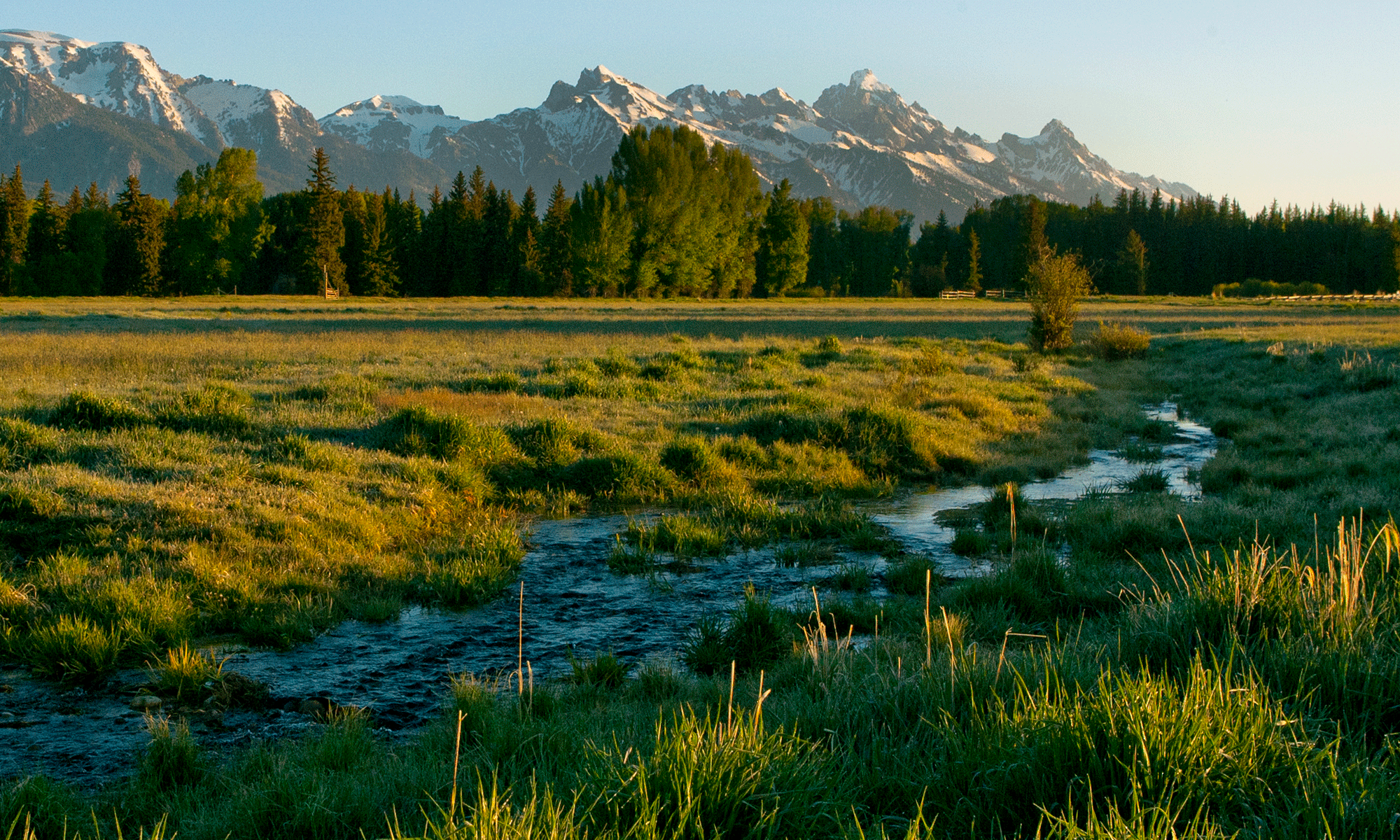
As the oldest and largest brokerage in Jackson Hole, we have an in-depth understanding of the local real estate market, strong community ties and unparalleled real estate experience. Jackson Hole Sotheby’s International Realty perennially leads the way in real estate sales in Teton County. We participated in three times the sales volume and twice the transactions of our closest competitor in 2011.
We are dedicated to delivering exceptional service and have a long history of exceeding the expectations of our discerning buyers. We look forward to working with you.
An Inland Island
Jackson Hole’s incredible uniqueness is articulated when you consider that we are virtually an inland island.
Today 97% of our land is forever preserved in national parks, national forests, Bureau of Land management
acreage of the National Elk Refuge and conservation lands, leaving only a small percentage available for
private ownership.
Jackson Hole is very finite in terms of real estate. The scarcity of remaining available land and limited land
development going into the future, ensures the character and openness of our valley will always remain.
Convenient Air Service
The Jackson Hole Airport is situated at the base of the spectacular Teton mountain range. Located entirely
within Grand Teton National Park, flying into the JH Airport is an awe inspiring welcome into the valley.
Jackson Hole is serviced by direct flights to and from Chicago, Dallas/Fort Worth, Denver, Salt Lake City, Atlanta and Los Angeles.
The Arts
Center for the Arts – A 41,000 sq. ft. Arts & Education Pavilion, a 500-seat theatre, Music Center, and theater rehearsal space. The Pavilion offers space for 20 nonprofit organizations creating an atmosphere of collaboration and inspiration.
National Museum of Wildlife Art – The museum is unique among American art museums, distinguished by its mission and location. With collections of nearly 4,000 works of art, the museum strives to enrich and inspire public appreciation of fine art and humanity’s relationship with nature. Situated just outside the town of Jackson, the museum overlooks the 20,000-acre National Elk Refuge and is en route to Grand Teton and Yellowstone National Parks.
Grand Music Festival – Celebrating their 50th year, Grand Teton Music Festival has inspired countless audiences with world-class concerts by the nation’s finest orchestra players. Led by music director, Donald Runnicles, the summer line up includes a stunning festival orchestra each weekend as well as sought after visiting musicians from around the
globe and delightful chamber music.
Art Galleries – There are about 30 to 40 galleries in Jackson featuring the best of Western art and more recently, newer galleries with a broader focus. The definition of art in the town and the surrounding valley of Jackson Hole has expanded with a popular international film festival, dedicated state-of-the art studios, and organizations such as the Art Association.
National Parks and Forest Lands
Grand Teton National Park
On the north end of Jackson Hole, Grand Teton National Park preserves a spectacular landscape rich with majestic mountains, pristine lakes and extraordinary wildlife. In the winter, the park’s main roadway is plowed and open for winter travel from the town of Jackson to Flagg Ranch near Yellowstone National Park’s south boundary. The Craig Thomas Discovery and Visitor Center in Moose is open year-round, except for December 25th.
Yellowstone National Park
Established in 1872, Yellowstone National Park is America’s first national park. Located ninety miles north of Jackson, it is home to a large variety of wildlife including grizzly bears, wolves, bison, and elk. Preserved within Yellowstone National Park are Old Faithful and a collection of the world’s most extraordinary geysers and hot springs, as well as the Grand Canyon of the Yellowstone.
Bridger-Teton National Forest
Easily accessed by Jackson Hole, Bridger-Teton offers more than 3.4 million acres of public land for outdoor recreation enjoyment. With its pristine watersheds, abundant wildlife and immense wildlands, these forest lands comprise a large part of the Greater Yellowstone Ecosystem – the largest intact ecosystem in the lower 48 States. Offering nearly 1.2 million acres of designated Wilderness, over 30,000 miles of road and trails and thousands of miles of unspoiled rivers and streams, the Bridger-Teton offers something for everyone.
Significant Tax Benefits
There are numerous reasons why those who live in Jackson Hole have chosen to have their primary residences here. Some of those reasons are emotional, such as the sheer beauty of the natural surroundings and the overall quality of life. Other reasons are more practical in scope and include Wyoming’s overall tax-climate benefits, when compared to all other states. For years, Bloomberg has rated Wyoming as the most tax-friendly state in the U.S. Here are the 10 top tax benefits offered by Brian Jones, a senior vice president at Bank of Jackson Hole.
1. No state income tax: With no state tax on personal or corporate income, “you have more disposable income,” Jones says.
2. Dynasty trusts: In Wyoming, you can shield your real estate from federal estate taxes for up to 1,000 years through a dynasty trust. “You can establish a trust in Wyoming for the benefit of your family or other beneficiaries,” Jones says. “You can transfer your real estate into a limited liability company or family partnership and then put that into the ‘dynasty trust,.” As a result, multiple generations can make use of and enjoy the property, without having to pay estate taxes or worse, having to sell the property in order to pay the taxes. A key point to remember: The trust must be administered in Wyoming.
3. No inheritance tax or estate tax: “Wyoming repealed its estate tax as of January 1, 2005,” Jones says.
4. No state gift tax: “Somebody who owns property in Wyoming can ‘gift’ that real estate to their heirs without having to worry about paying a state gift tax,” Jones says.
5. No tax on out-of-state retirement income: “A lot of people in Jackson Hole use Wyoming as a second home,” Jones says. “They have retirement income that comes from other states where they may be a resident. Wyoming doesn’t tax that retirement income that’s earned outside of Wyoming, which is certainly beneficial.”
6. Low property taxes: “Wyoming has very low property taxes compared to other states,” Jones says. “The taxes that you do pay here are based on the assessed value of the property.”
7. No excise taxes: When you fill up your car’s gas tank or buy groceries in Wyoming, you won’t pay any state tax on your gas or food.
8. No tax on mineral ownership. “A lot of states charge owners a tax on their mineral ownership, but Wyoming does not,” Jones says. “If you own minerals, you won’t pay a tax on it like you would your home.
9. No intangible taxes: Wyoming doesn’t make you pay a tax on financial assets like stocks and bonds.
10. No tax on the sale of real estate.
Wyoming Fiscal Responsibility
While many states are wrestling with how to close widening budget deficits, Wyoming lawmakers are determining where to park the state’s surplus. Wyoming is a leading mineral producing state and gets significant revenue from natural gas, coal and other minerals. The Wyoming state budget surplus is more than $1 billion.
Recently reported by the Denver Branch of the Federal Reserve Bank, the current condition of Wyoming’s
economic health and prospects for recovery look promising. Here are a few observations:
• After the contraction of 2009, Wyoming has added more than 3,000 jobs through August 2010
• Residential construction in Wyoming one of the leading states in the U.S.
• Population and labor force losses remain minimal
• Retail activity is improving
• Wyoming will well positioned for economic health entering 2011
Protecting The Lands we Love
Jackson Hole Land Trust and Nature Conservancy
With 97 percent of Jackson Hole’s land protected as national parks and forests, it’s easy to assume that elk, mule deer, antelope and other key wildlife species have plenty of room to roam between their winter and summer stomping grounds. But Jackson is part of a much bigger, scientifically important region, the Greater Yellowstone Ecosystem, and the tiny 3 percent of land here that is privately owned is part of a network of critical migration corridors through the ecosystem.
The Land Trust and The Nature Conservancy are on a mission to protect enough open space for the Yellowstone region’s wildlife to get where they need to go. Through conservation easements and other land-preservation tools, they are working acre by acre to protect important terrain ensuring our valley maintains it visually spectacular character and remains open for wildlife.


